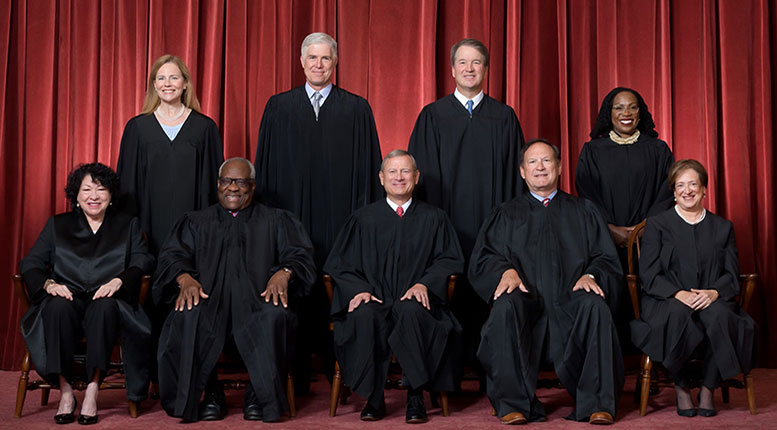OP-ED: The Supreme Court Reverses Colorado’s Supreme Court Decision On A Technicality of Sorts; Lets Trump Stay On State’s Ballot
By: Chris Gilmore/The Rainbow Times—
The U.S. Supreme Court — siding with Trump — voted to keep the former President on the Colorado ballot, regardless of his role in the Capitol riots that took place on January 6. This is the assistance that Trump desperately needed from this Court. And “his” Justices — those he nominated, (and his allies within it too) — did not disappoint.
The High Court’s decision overturns the Colorado ruling from this state’s Supreme Court in Trump v. Anderson, which removed Trump from the ballot in that state. This decision can threaten other states’ considerations, decisions, and/or actions to take the former president off their ballots due to their interpretation of the 14th Amendment provision. The provision states that those who engage in an insurrection after taking an oath to support the Constitution are disqualified from holding office again.
Fourteenth Amendment – Section 3
Although Trump’s Lead Counsel Jonathan Mitchell cited that it was not an insurrection, based on the reading of Section 3, primarily due to it failing to be an “organized” riot, it was indeed organized by Trump himself. At his orders, Trump’s henchmen organized the pseudo-rally and encouraged people to storm the capitol, which resulted in the deaths and injuries of many. The whole point of the insurrection was to stop the peaceful transfer of power, in other words to overthrow the governmental process.
Section 3 of the 14th Amendment reads that “No person shall be a Senator or Representative in Congress, or elector of President and Vice-President, or hold any office, civil or military, under the United States, or under any State, who, having previously taken an oath, as a member of Congress, or as an officer of the United States, or as a member of any State legislature, or as an executive or judicial officer of any State, to support the Constitution of the United States, shall have engaged in insurrection or rebellion against the same, or given aid or comfort to the enemies thereof. But Congress may by a vote of two-thirds of each House, remove such disability.”
What is an insurrection?
Trump had hours, days, and weeks of colluding, conspiring, and premeditated plans of attack if he lost the election. He spoke to Vice-President Mike Pence about refusing to certify the election results prior to January 6. When things started to spiral out of control, he did nothing to stop the onslaught of violence that took place at the Capitol that infamous day. Some of his White House team has attested to it in numerous interrogations conducted by the January 6th Commission. Trump was the mastermind of the plan to overthrow the government. If that isn’t organization, then, what is?
But, today Associate Justice Ketanji Brown Jackson masterfully questioned Mitchell as to why this was not an insurrection, to what he answered: “We never accepted nor conceded in our opening brief that this was an insurrection. What we said in our opening brief was President Trump did not engage in any act that can plausibly be characterized as insurrection.”
Seeking further clarification, Justice Jackson asked again the reasoning behind it not being considered an insurrection by Trump’s attorneys.
“Alright, so, why would this not be an insurrection? What is your argument that it’s not? Your reply brief says that it wasn’t because, I think you say, it did not involve an organized attempt to overthrow the government,” said the Justice.
“That’s one of many reasons, but for an insurrection there needs to be an organized, concerted effort to overthrow the government of the United States through violence,” answered Mitchell.
The Justice continued her line of questioning seeking a clearer answer from the counsel.
“And, so, the point is that a chaotic effort to overthrow the government is not an insurrection?” asked Justice Jackson.
A seemingly aggravated Mitchell replied.
”No, we didn’t concede that it’s an effort to overthrow the government either, Justice Jackson,” he said.
“None of these criteria were met. This was a riot. It was not an insurrection. The events were shameful, criminal, violent, all of those things. But it did not qualify as an insurrection, as the term is used in Section 3.”
If a crime boss — read any citizens of this nation who isn’t rich or powerful — orders a hit on an opponent and the henchmen carry it out, the crime boss would certainly be prosecuted as the mastermind behind it. Or, should we expect from this point on to dissect words and concepts to allow the crime boss to be freed on such technicality?
Trump’s intent was clear that day. We all witnessed it. Can you imagine if this were President Barack Obama instead of Trump? Imagine it.
It is notable to mention that the 5-4 decision was split by gender: the five male Justices voted for the reversal (for Trump’s team), while the remaining four female justices partially concurred and dissented (three for similar reasons and one — Associate Justice Amy Coney Barrett — for a different one).
Listen to Justice Ketanji Brown Jackson question Trump’s team usage of the word “insurrection.”
It argued, in the decision that the majority of the Justices made that it was “Because the Constitution makes Congress, rather than the States, responsible for enforcing Section 3 against federal officeholders and candidates, we reverse.”
Three Justices’ partially dissent
The 5-4 decision, according to 3 of the dissenting Justices, Associate Justices Sonia Sotomayor, Elena Kagan, and Associate Justice Ketanji Brown Jackson, was something that should not have been changed.
“What it does today, the Court should have left undone,” part of their opinion stated.
Bush v. Gore, 531 U. S. 98, 158 (2000) (Breyer, J., dissenting). The Court today needed to resolve only a single question: whether an individual State may keep a Presidential candidate found to have engaged in insurrection off its ballot. The majority resolves much more than the case before us. Although federal enforcement of Section 3 is in no way at issue, the majority announces novel rules for how that enforcement must operate. It reaches out to decide Section 3 questions not before us, and to foreclose future efforts to disqualify a Presidential candidate under that provision. In a sensitive case crying out for judicial restraint, it abandons that course.
The Justices, in their limited concurring dissent [emphasis added] explained how the majorities’ role was not to limit Section 3 of the Constitution.
Section 3 serves an important, though rarely needed, role in our democracy. The American people have the power to vote for and elect candidates for national office, and that is a great and glorious thing. The men who drafted and ratified the Fourteenth Amendment, however, had witnessed an “insurrection [and] rebellion” to defend slavery. §3. They wanted to ensure that those who had participated in that insurrection, and in possible future insurrections, could not return to prominent roles. Today, the majority goes beyond the necessities of this case to limit how Section 3 can bar an oath breaking insurrectionist from becoming President.
Although we agree that Colorado cannot enforce Section 3, we protest the majority’s effort to use this case to define the limits of federal enforcement of that provision. Because we would decide only the issue before us, we concur only in the judgment.
The opinion was, as other media has quoted, “a massive victory” for Trump’s team and it did what they needed it to do. It allows Trump, to remove one of the obstacles he is facing to run in the 2024 elections against presidential incumbent and Democratic nominee Joe Biden, to run as the GOP’s front-runner. However, Trump’s legal woes do not end there, and depending on the results of such cases, he may be faced with other obstacles that could prevent him from running or holding office in the end.
Trump’s legal woes still remain … vote
The twice impeached, four times indicted (in four different jurisdictions, and something that’s never happened before) former president has also been held liable by various civil court cases. Overall, he faces 91 criminal counts (list of cases against Trump). In NYC, a judge ruled a $355 million judgment against him. Earlier this year, Trump was found liable for more than $83 million for defaming E. Jean Carroll. Before that, another jury found him liable for sexually abusing her. Regardless, his MAGA supporters continue to fuel and support his re-election campaign.
For a list of Trump’s current and pending legal cases, click here. Find out this decision could affect the future of LGBTQI+ rights, women’s rights, people of color, and other’s rights. And, for crying out loud, #vote!







